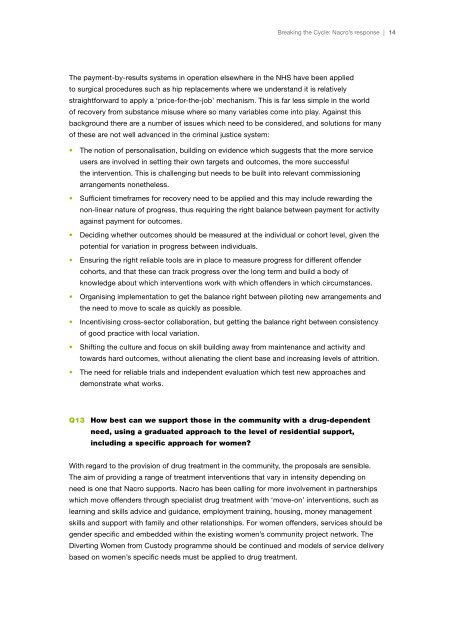Nacro's response to Breaking the Cycle Green Paper
Nacro's response to Breaking the Cycle Green Paper
Nacro's response to Breaking the Cycle Green Paper
You also want an ePaper? Increase the reach of your titles
YUMPU automatically turns print PDFs into web optimized ePapers that Google loves.
<strong>Breaking</strong> <strong>the</strong> <strong>Cycle</strong>: Nacro’s <strong>response</strong> | 14The payment-by-results systems in operation elsewhere in <strong>the</strong> NHS have been applied<strong>to</strong> surgical procedures such as hip replacements where we understand it is relativelystraightforward <strong>to</strong> apply a ‘price-for-<strong>the</strong>-job’ mechanism. This is far less simple in <strong>the</strong> worldof recovery from substance misuse where so many variables come in<strong>to</strong> play. Against thisbackground <strong>the</strong>re are a number of issues which need <strong>to</strong> be considered, and solutions for manyof <strong>the</strong>se are not well advanced in <strong>the</strong> criminal justice system:• The notion of personalisation, building on evidence which suggests that <strong>the</strong> more serviceusers are involved in setting <strong>the</strong>ir own targets and outcomes, <strong>the</strong> more successful<strong>the</strong> intervention. This is challenging but needs <strong>to</strong> be built in<strong>to</strong> relevant commissioningarrangements none<strong>the</strong>less.• Sufficient timeframes for recovery need <strong>to</strong> be applied and this may include rewarding <strong>the</strong>non-linear nature of progress, thus requiring <strong>the</strong> right balance between payment for activityagainst payment for outcomes.• Deciding whe<strong>the</strong>r outcomes should be measured at <strong>the</strong> individual or cohort level, given <strong>the</strong>potential for variation in progress between individuals.• Ensuring <strong>the</strong> right reliable <strong>to</strong>ols are in place <strong>to</strong> measure progress for different offendercohorts, and that <strong>the</strong>se can track progress over <strong>the</strong> long term and build a body ofknowledge about which interventions work with which offenders in which circumstances.• Organising implementation <strong>to</strong> get <strong>the</strong> balance right between piloting new arrangements and<strong>the</strong> need <strong>to</strong> move <strong>to</strong> scale as quickly as possible.• Incentivising cross-sec<strong>to</strong>r collaboration, but getting <strong>the</strong> balance right between consistencyof good practice with local variation.• Shifting <strong>the</strong> culture and focus on skill building away from maintenance and activity and<strong>to</strong>wards hard outcomes, without alienating <strong>the</strong> client base and increasing levels of attrition.• The need for reliable trials and independent evaluation which test new approaches anddemonstrate what works.Q13 How best can we support those in <strong>the</strong> community with a drug-dependentneed, using a graduated approach <strong>to</strong> <strong>the</strong> level of residential support,including a specific approach for women?With regard <strong>to</strong> <strong>the</strong> provision of drug treatment in <strong>the</strong> community, <strong>the</strong> proposals are sensible.The aim of providing a range of treatment interventions that vary in intensity depending onneed is one that Nacro supports. Nacro has been calling for more involvement in partnershipswhich move offenders through specialist drug treatment with ‘move-on’ interventions, such aslearning and skills advice and guidance, employment training, housing, money managementskills and support with family and o<strong>the</strong>r relationships. For women offenders, services should begender specific and embedded within <strong>the</strong> existing women’s community project network. TheDiverting Women from Cus<strong>to</strong>dy programme should be continued and models of service deliverybased on women’s specific needs must be applied <strong>to</strong> drug treatment.
















